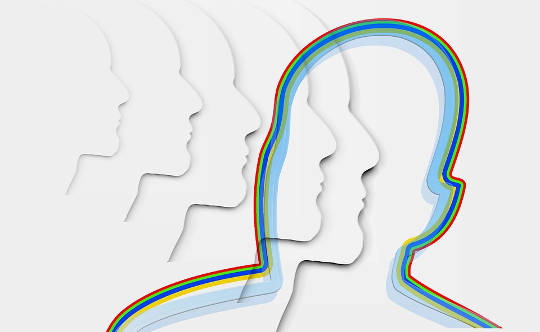 Artwork: Max Pixel (cc0)
Artwork: Max Pixel (cc0)
There is a natural tendency to synchronize, to link up with others. Fireflies flash in unison by the thousands. Women who live together regularly have their menstrual cycles sync up. In 1665 Christiaan Huygens observed that his two pendulum clocks would swing in unison when they were hanging on the same support.
Remarkably, this same phenomenon takes place on the level of planets, protons, and persons, essentially on every level of the cosmos. Synchrony — ordered behavior through time — occurs everywhere, from the quantum level to the herd mentality of stock traders.
The kind of linking in empathy is not only about rhythm but also about frequency. When two violins are located in the same room and a string is plucked on the first one, the string tuned to the same frequency on the second violin will vibrate, thus sounding the note. In the field of acoustics, this is called sympathetic resonance.
Lovers, parents, close friends, a good therapist and their patient, or a child and their puppy can recognize a kind of emotional resonance as we “feel into” the other or pick up their “vibes” or get “in sync” with them. Through this resonance, we have the capacity to know the other with profound immediacy and directness and, in so doing, come in touch with their pain, anger, or joy very quickly.
I Feel What You Feel
Neuroscience has been uncovering a bit of the hardwiring for this linking between mammals. Brain structures called mirror neurons are capable of responding instantaneously to the emotions or actions of another person in such a way that the brain of someone witnessing another person is activated as if they were the person they were seeing. This neurobiological phenomenon was first identified in macaque monkeys.
A monkey was hooked up to electroencephalogram (EEG) measuring brain electrical activity. Researchers recorded patterns of brain activity when the monkey peeled a banana. What surprised the researchers was that when another monkey or a person peeled a banana in front of the wired-up monkey, the same areas of the brain were activated as if the hooked-up monkey were peeling it himself. It wasn’t just that he was seeing it; it was as if he were doing it.
Just like two singers finding the right pitch, when we successfully link up with someone, we harmonize in some way. This linking or looping also happens with the athletic team, the loving couple, a mother and child — even with those who have had a rough start in life.
The Roots of Empathy
In response to rising levels of aggression in schoolchildren, Mary Gordon, president of the Roots of Empathy program, has taken the unlikely step of bringing babies and mothers into public school classrooms in various countries around the globe.The program introduces a mother and her new baby to a classroom for twenty-seven visits over a school year.
An instructor from the program accompanies them and coaches the students to observe the baby’s development and label the baby’s feelings throughout the visit (“What do you think the baby is feeling?”). The instructor also invites students to notice and reflect upon their own feelings and one another’s feelings along the way (“What are you thinking?”).
Mary relayed the story of Darren: “Darren was the oldest child I ever saw in a Roots of Empathy class. He was in grade 8 and had been held back twice. He was two years older than everyone else and was already starting to grow a beard.” Mary knew his story. “His mother had been murdered in front of his eyes when he was four years old, and [he] had lived in a succession of foster homes ever since. Darren looked menacing because he wanted us to know he was tough; his head was shaved except for a ponytail at the top and he had a tattoo on the back of his head.”
The instructor of the Roots of Empathy program was explaining to the class about the differences in temperament that day. She invited the young mother who was visiting the class with Evan, her six-month-old baby, to share her thoughts about her son’s temperament. Joining in the discussion, the mother told the class how Evan liked to face outward when he was in the Snugli and didn’t want to cuddle into her and how she would have preferred to have a more cuddly baby.
What About Me?
As the class ended, the mother asked if anyone wanted to try on the Snugli, which was green and trimmed with pink brocade. To everyone’s surprise, Darren offered to try it on, and as the other students scrambled to get ready for lunch, he strapped it on. Then he asked if he could put Evan in. The mother was a little apprehensive but then handed him her baby.
Darren then put Evan in the Snugli, facing toward his chest. Instantly and to his mother’s surprise, Evan snuggled right in. Darren gently took him to a quiet corner and rocked back and forth with the baby in his arms for several minutes as the jaws of those looking on dropped, amazed by Darren’s tenderness. Finally, Darren went back to where the mother and the instructor were waiting and asked, “If nobody has ever loved you, do you think you could still be a good father?”
When systems link, whether within us or between us, such as with Darren and baby Evan, we find harmony. When we fail to harmonize and integrate, living systems, from individuals to families and countries, tend to move toward either chaos or rigidity.
Practice: Linking Up
In a group setting, pair up with a partner and face each other in an attentive posture. Take a few moments to relax your minds and become more present. With an attitude simply of curiosity and appreciation, see if you can meet the other. You are asked to be open to the encounter, both to meet and to be met.
It is important not to probe or invade the other in any way. Instead, just meet in that space between you (what Martin Buber called “the between”). The process will involve opening your eyes periodically to catch a glimpse or brief view of your partner. Then close them again and repeat as it seems right, as staring at each other is often too intense. Do this in silence and simply notice what arises in your awareness.
After a few minutes, stop and take some time to share what you noticed in whatever way this came to you — feelings, vague impressions, images, or hunches related to the person or the meeting. It is not unusual for there to be a sense of intimacy and connection among many, although not everyone feels this way.
Did any insights, feelings, sensations, or questions that arise? Check out the accuracy of your impressions. In addition, process what the experience of meeting in this way was like for each of you, noticing when and how you were open or how you might tend to hold back. How this is similar or different to what you do in other situations?
Practice: Points of View
Recall the Roots of Empathy instructor’s questions to the children: “What do you think the baby is feeling?” and “What are you feeling?”
Being able to intentionally turn our attention to others’ feelings as well as our own opens the gates for contact and self-awareness. Being able to compare our perceptions with others allows us to open the possibility of multiple points of view.
“Oh, yeah, now that you mention it, I did feel that. I just didn’t think anything of it until you said something about it. I need to trust that more.” Or “I never thought of seeing it that way.”
These simple questions — “What are you feeling? What do you think they are feeling?” — begin to expand empathic capacity. In addition, sharing our perceptions of others directly with them allows us to get some direct feedback on the accuracy of our emotional reading.
“Are you feeling betrayed?” or “I would feel betrayed if it were me. How about you?”
The response allows us to refine our accuracy. Simply reflecting back what someone has said, felt, or meant is a way to check out the accuracy of our perceptions and reveal our projections. We might try this gently as an intentional practice with those we encounter throughout the day. In addition, using an imaginative process helps open up new vistas. “How would I feel if I were the terrorist? A new mother? A crying child?”
Practice: Read My Lips
The goal here is to practice noticing the face and the body’s subtle cues. While this is a natural skill for most, it is also one that can be developed. There are a variety of ways to do this, but the basic idea is to simply observe faces (and other body language as well) and try to identify the feelings that seem predominant.
You might simply take photos from a magazine or observe people in a restaurant whose conversations you cannot hear. You might watch a movie or TV show with the sound off. Try to identify the feeling(s) portrayed. Sharing these with others to compare notes is a good way to gain some confirmation and see a greater range of possible feelings.
You might also “listen” to someone with your ears covered and ask them to speak in a low enough voice so you can’t hear them. Again, try to identify the feelings without knowing what the content is. Notice how your own face and body want to respond to them.
There are many variations on this practice, but the bottom line is to observe body expression without verbal content, identify the feelings present, and compare notes to check for accuracy.
©2014 Tobin Hart. Reprinted with permission
from Atria Books/Beyond Words Publishing.
All Rights Reserved. www.beyondword.com
Article Source
The Four Virtues: Presence, Heart, Wisdom, Creation
by Tobin Hart, PhD.
 By drawing from across tradition and time, from neuroscience to ancient wisdom, Tobin Hart reveals that we all possess four essential virtues — Presence, Heart, Wisdom, Creation — that help us to build, balance, and integrate our psychological and spiritual life on earth. This highly accessible, thought-provoking guide shows us how to grow and activate these powers from the inside out.
By drawing from across tradition and time, from neuroscience to ancient wisdom, Tobin Hart reveals that we all possess four essential virtues — Presence, Heart, Wisdom, Creation — that help us to build, balance, and integrate our psychological and spiritual life on earth. This highly accessible, thought-provoking guide shows us how to grow and activate these powers from the inside out.
Click here for more info and/or to order this book on Amazon.
About the Author
 Tobin Hart, PhD, is a father, professor, psychologist, speaker, and author of The Secret Spiritual World of Children. He has spent more than thirty years as a researcher and ally helping students, clients, and patients integrate their psychological and spiritual lives. He serves as professor of psychology at the University of West Georgia, as well as co-founder and president of the ChildSpirit Institute, a nonprofit educational and research hub exploring the spirituality of children and adults.
Tobin Hart, PhD, is a father, professor, psychologist, speaker, and author of The Secret Spiritual World of Children. He has spent more than thirty years as a researcher and ally helping students, clients, and patients integrate their psychological and spiritual lives. He serves as professor of psychology at the University of West Georgia, as well as co-founder and president of the ChildSpirit Institute, a nonprofit educational and research hub exploring the spirituality of children and adults.























